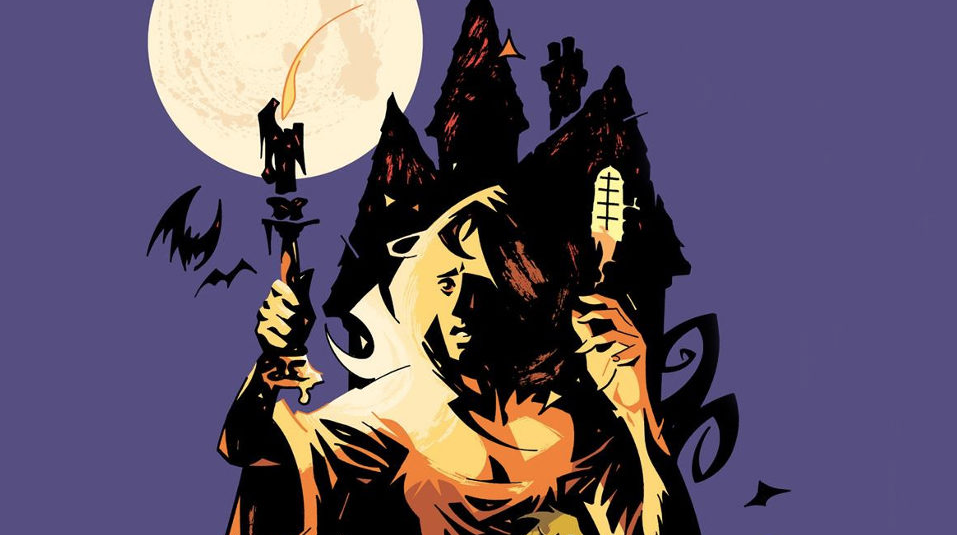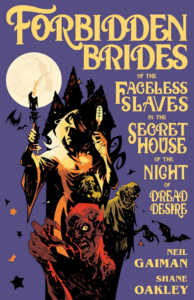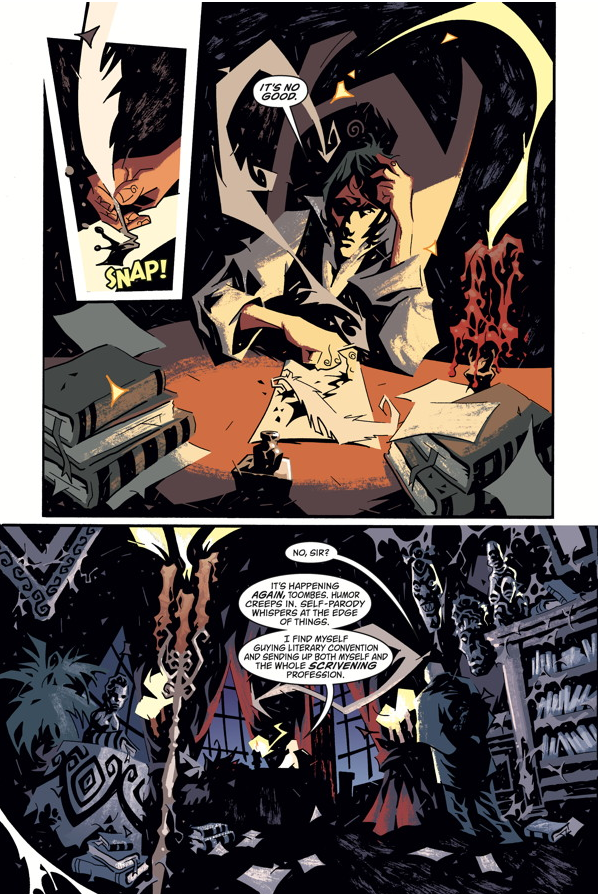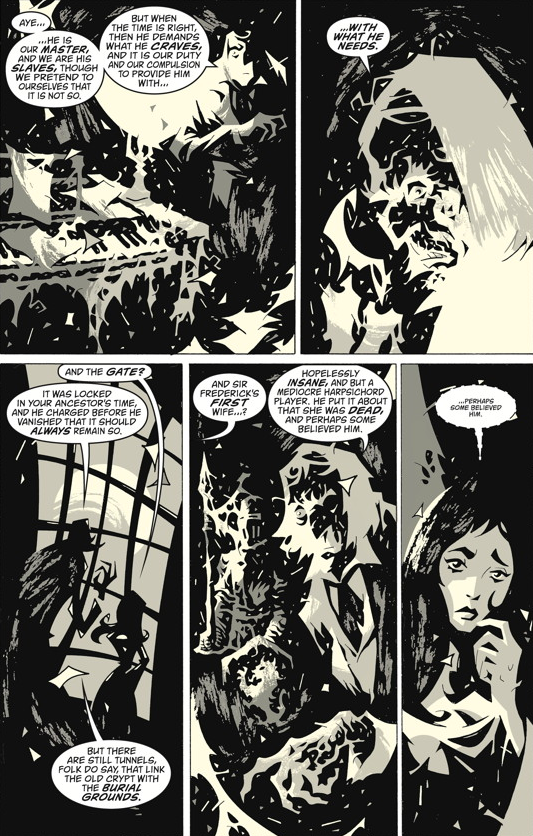
Forbidden Brides of the Faceless Slaves in the Secret House of the Night of Dread Desire
Story: Neil Gaiman
Adaptation & Art: Shane Oakley
Colourist: Nick Filardi
Letterer: Todd Klein
Publisher: Dark Horse
A review by Stephanie Pouliotte
“ Somewhere in the night, a raven caws, an author’s pen scratches, and thunder claps.”
Somewhere in the night, a raven caws, an author’s pen scratches, and thunder claps.”
Forbidden Brides of the Faceless Slaves in the Secret House of the Night of Dread Desire is a brilliantly brooding and sinister parody of Gothic horror literature in which a serious non-fiction author sits in his cold, eerie mansion on a stormy night, unable to complete his great work. Try as he might to write a slice-of-life story where pale, raven-haired women holding candelabras are lured into dark crypts or undead ghouls rise to honour old compacts signed in blood, he’s unable to stop himself from inserting unexpected humour that turns it all on its head and which, to him at least, makes a gross mockery of an art form meant to mirror his dark and gloomy reality.
He’s haunted by the Gothic tropes that surround him in his waking life, like strange creatures scuttling in the shadows, tawny eyes looking down from old portraits, and the occasional duel to the death over blood rights. All are commonplace in his world, but he’s unable to find solace in writing about it. That is, until he gets advice from a talkative raven, naturally perched on a white marble bust of this great-great-great grandfather, who tells this self-proclaimed Classicist what it means to write fantasy in a world where the strange and supernatural are considered mundane.

Forbidden Brides first appeared in Neil Gaiman’s 2006 collection of short fictions and wonders Fragile Things, but this satirical tale was actually penned in 1983 by a nervous young writer who boldly turned the manuscript over to a couple of editors he knew. As it turns out, neither liked it very much, calling it facetious rubbish and stating that, frankly, it didn’t seem like anybody’s thing and likely wouldn’t be published at all. In a 2003 journal, Gaiman recounts feeling faintly embarrassed by it and glad to have been spared any further, more public humiliation as he shoved it away in a drawer to be forgotten for the next twenty years. When he was approached to write for an anthology called Gothic!, he recalled Forbidden Brides and dug up the old manuscript from the attic to see what could be salvaged from the so-called “rubbish”. He was surprised to find that it held up quite nicely, “The funny bits were pretty funny, the style was solid, some of it prefigured things I’d do in Sandman four years later. It’s about what fantasy is, and why we write it, and what it would mean to write fantasy if you lived in a Gothic universe.”
It was published after only minor rewrites and went on to win Best Short Story in the 2005 Locus Awards, serving as a reminder that not every criticism is worth its weight. Young writers are often easily swayed by the opinions of others, but “sometimes you just show stories to the wrong people, and nobody’s going to like everything.” In the end, it all comes down to whether or not you’re happy with what you’ve done and whether you were happy writing it in the first place. Forbidden Brides coincidentally deals with similar ideas, as the writer is convinced he’s continually sabotaging himself with his own pen, struggling against his own self-criticism and his conflicting ideas of what is, or isn’t, good literature. He believes a writer should hold a mirror to life and that only stories that are accurate and true depictions of reality can speak to the human condition.
Yet the story he’s in, which reads as a meld of Gothic satire and dark fantasy, does exactly that. It certainly is a bit of meta-fiction, as the story in itself proves its own point about how good fantasy can be just as true and fulfilling as any nonfiction work. His journey as a writer mirrors the real experiences of other struggling authors, and I’m sure Gaiman felt the same uncertainties and frustrations when he was told his story was facetious nonsense. Like the author in his story, Gaiman believed, at the time, that he needed to follow the subjective rules of the game as it were, and that going beyond that would end up being widely disliked. But I’ve always admired his writing because it seems to me he only learned the rules so he would know how to bend and change them (or avoid them altogether.) The ending of Forbidden Brides is an unexpected take on fantasy in a Gothic world and provides a cathartic release for any writer who’s been haunted by the ghosts of the literary greats.
Shane Oakley’s adaptation draws beautifully on the classic Gothic tropes, while maintaining his signature style. The story weaves between the author’s study and the Gothic mansion in the story, distinguishing between the two worlds by going from full colour to black and white. Oakley’s heavy use of shadow forms haunting silhouettes, defined only by pale accents of flickering candlelight and forks of lightning, cloaking the characters in an enthralling and unsettling atmosphere. Nick Filardi’s inky midnight colours dramatically enhance the setting and are a welcome reprieve from the busy monochrome passages.
The artwork was absolutely mesmerizing, with jagged angles and heavy inking that grounds the story even further in its pastiche of Gothic horror without becoming an exaggerated caricature. I did feel that the black and white passages were particularly dense, as details and features are simultaneously swallowed and defined by the surrounding darkness. Though having to really focus on each panel usually pulls me out of a story, in this case it adds to the disquieting ambiance, personifying a kind of chaotic madness that makes the reader feel misplaced and out of sorts.

The Verdict
Buy It! Shane Oakley skillfully adapts this mysteriously compelling and comically dark tale about an author who fails his way to writing fantasy. Forbidden Brides of the Faceless Slaves in the Secret House of the Night of Dread Desire is a gorgeous graphic novel and a must read for any Gothic horror enthusiasts, though it may be less accessible to readers who aren’t familiar with the tropes of the genre. It’s a disjointed story that jumps around quite a bit, and the finer plot points may be lost in the dense pastiche.
Fans will certainly want to add this to their growing library of Gaiman adaptations, and reading the story as a graphic novel certainly makes the similarities to his later work in Sandman stand out all the more. In fact, there’s a reference to this short story at the end of The Sandman: The Doll’s House, where a character named Zelda dreams of “Gothic Heroines Secret Brides of The Faceless Slaves of The Forbidden House of The Nameless Night of The Castle of Dread Desire.”
Forbidden Brides of the Faceless Slaves in the Secret House of the Night of Dread Desire will be in comic shops on January 25.



